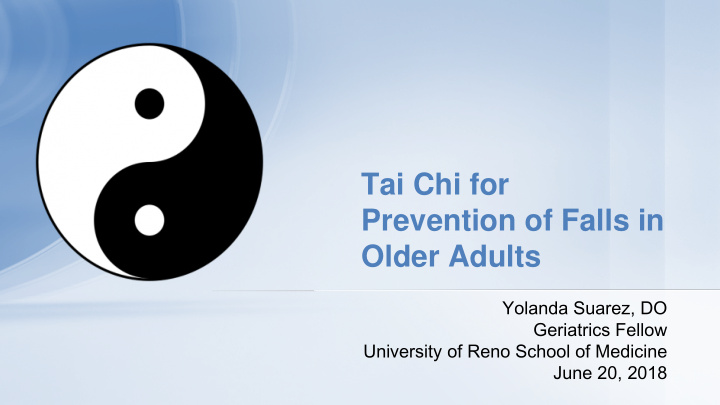



. Tai Chi for Prevention of Falls in Older Adults Yolanda Suarez, DO Geriatrics Fellow University of Reno School of Medicine June 20, 2018 .
. • Identify fall risks in older adults using risk assessment tools Through this • Develop a plan to reduce risks interactive of falls in older adults presentation • Talk about the origins and you will learn types of Tai Chi to… • Discuss the benefits of Tai Chi for falls prevention in older adults .
. Case Study Mrs. W. is a 75 year old female • Lives alone • Uses a cane when walking • 2 falls in past year and fractured right wrist • Sedentary Medications: PMHx: • Hydrochlorothiazide 25 • HTN mg daily • Arthritis • Paroxetine 40 mg daily • Depression • Naproxyn 500mg twice • Hyperlipidemia daily • Simvastatin 80mg daily .
. What is the a)Orthostatic Hypotension single most b)Dementia predictive risk c) Diuretics factor for a d)Prior Fall fall? e)Arthritis .
. Blood Pressure Weight Height BMI Seated: 110/70 103 lb 5 ft 3 in 18.24 Standing: 95/60 • Gait is slow and slightly unsteady Physical • Requires use of both arms to push out of chair • Dizziness when standing Exam • Impaired Balance Labs: • Vitamin D: 18 ng/mL • TSH: 10.2 mU/L • FT4: 0.6 ng/dL .
. Risk Factors for Falls in Older Adults Potentially Modifiable Nonmodifiable Cardiac Neurologic Age >80 years Congestive Heart Failure Delirium Arthritis Cardiac arrythmias Dizziness or vertigo Dementia Hypertension Movement disorders Female Sex Environmental Hazards Peripheral Neuropathy History of CVA Medications Psychological History of falling Metabolic Depression History of fractures Diabetes Fear of Falling Recent hospital discharge Low Body Mass Index Sensory Impairment White Race Vitamin D Deficiency Auditory Musculoskeletal Multifocal lens Balance Impairment Visual Foot Problems Other Gait Impairment Acute Illness Impaired ADL's Anemia Limited Activity Cancer Lower Extremity Weakness Inappropriate Footwear Musculoskeletal Pain Nocturia Need for assistive device Obstructive Sleep Apnea Postural Hypotension Urinary Incontinence .
. STEADI Fall Risk Assessment Tool .
. Fall Risk Self Assessment 8 .
. High Risk Interventions .
. Medications Associated with Falls Anticonvulsants Laxatives Antidepressants Opioids Anti-hypertensives Muscle Relaxants Antiparkinsonian Drugs Non-benzodiazepine, benzodiazepine receptor agonist hypnotics Antipsychotics Non-Steroidal Anti-inflammatory drugs Benzodiazepines Sedatives and hypnotics Digoxin Diuretics .
. a) Declines in functional Which of the status following can b) Higher likelihood of result when nursing home placement an older c) Increased need for person falls? medical services d) All of the above .
. • Decline in baroreflex sensitivity Blood Pressure • Decreased resting cerebral perfusion Regulation • Reduced of total body water in Older Adults • Lower levels of basal and stimulated renin and aldosterone .
. a) Muscle-strengthening exercises Which of the 1-2 days/week for 20-30 following minutes activities b) Balance training more than 3 times/week reduce falls in c) Stretching 10 minutes/daily older adults? d) Vigorous intensity activity >75 minutes/day .
. a) Medication Review b) Vitamin D Interventions supplementation shown to be c) Use of Appropriate effective in Footwear d) Exercise programs that reducing falls include strengthening and balance exercises like Tai Chi e) All of the Above .
. a) Stop Hydrochlorothiazide b) Stop paroxetine and start escitalopram and refer to a mental health specialist Treatment c) Refer to nutritionist Plan d) Vitamin D 1000 units/day e) Levothyroxine 25mcg/day f) Prescribe a strengthening and balance exercise program g) All of the above .
. Older adults tend to: • Activate proximal muscles Postural • Co-contract antagonistic muscles Control • Have a decline in the ability to rapidly develop joint torque • Have declines in visual, proprioception and vestibular systems .
. • Rigidity of leg musculature • Inability to correct sway Falls Due to trajectory because of slowness of movement Parkinson’s • Hypotensive effects of Disease medication • Cognitive Impairment .
. • Ancient Chinese practice • Created as a fighting system but over Origins of time found to have health properties • Stems from Henan Province of China Tai Chi • First Tai Chi teachers came to America in the 1960’s • Tai Chi is a type of Qigong • The essential principles of Tai Chi are based on Taoism • Yin and yang .
. • Chen Types of • Yang Tai Chi • Wu • Hao .
. • Mindfulness Health • Imagery • Structural Alignment Benefits of • Flexibility and Relaxation Tai Chi • Strength and Balance • Natural Breathing • Social Support • Integration of body, mind and spirit .
. • Qi — an energy force thought to flow through the body; tai chi is said to Belief unblock and encourage the proper flow of qi. Systems • Yin and yang — opposing elements thought to make up the universe that need to be kept in harmony. Tai chi is said to promote this balance. .
. • Uses smooth and continuous rhythmical flow • Teaches step position and Mechanics strategies • Enhances flexibility of Tai Chi • Requires whole body coordination, somatosensory awareness and balance • Brings attention to internal as well as external coordinates in space .
. • Decrease in falls due to improvement in static and dynamic balance • Decreased fear of falling • Improvements in single leg balance Evidence and forward trunk flexion • Improved grip strength and lower body flexibility • Better proprioception in the ankle and knee joints in comparison to swimmers, runners and controls. .
. Plantar Distribution in Tai Chi Practitioners .
. Video--The Benefits of Tai Chi .
. Blood Pressure Weight Height BMI Seated: 130/70 110 lb 5 ft 3 in 19.48 Six Months Standing: 125/65 • Gait speed increased Later…. • Able to rise out of chair without pushing off • Improved Balance; no need for cane • No depression • Tai Chi three times/week and walking five days/week Labs: • Vitamin D: 30 ng/mL • TSH: 4.1 mU/L • T4: 1.4 ng/dL .
. The End Thank you! Questions? .
Recommend
More recommend